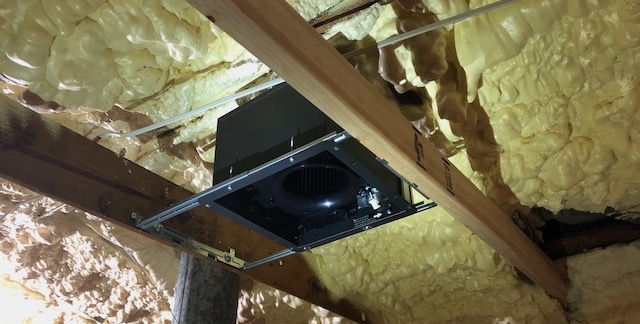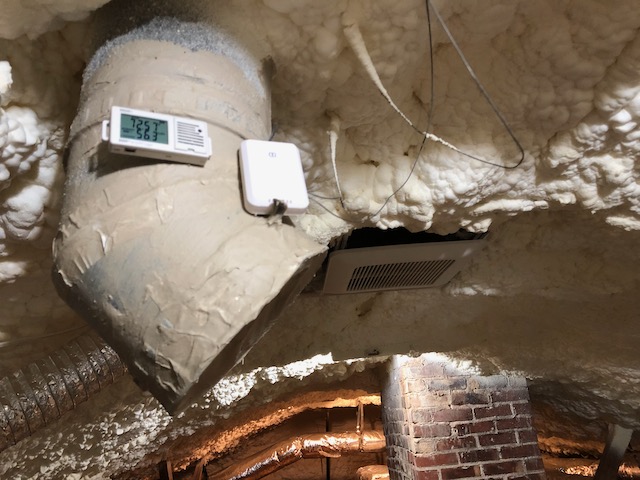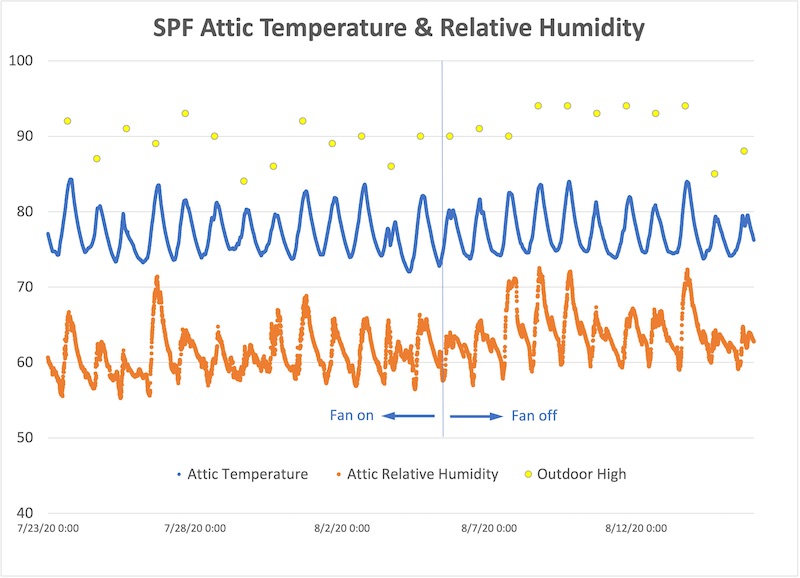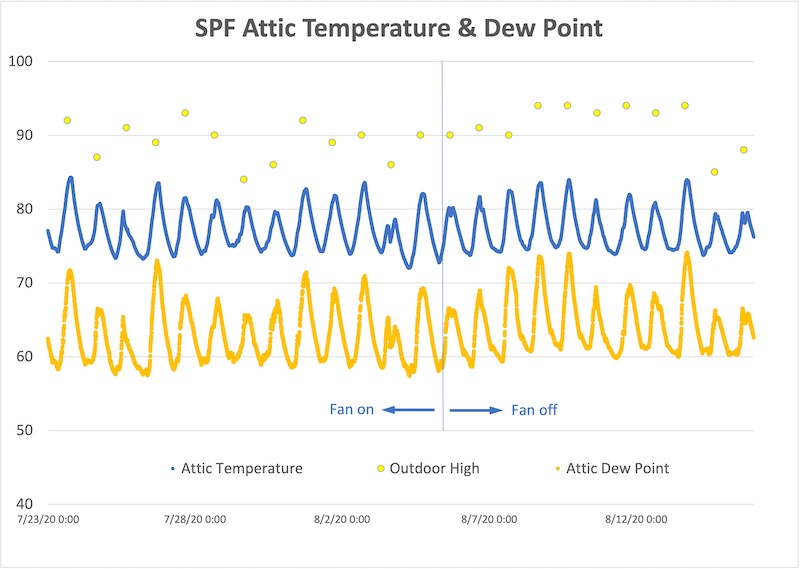Will a Continuous Fan Running in the Attic Help Moldy Smell
Here in the South, we love our humidity. It makes us glisten in the summer. But we also love our air conditioning and low humidity inside our homes. To save on air conditioning costs, more and more homes have attics encapsulated with spray foam insulation to bring the HVAC systems and ductwork inside the conditioned space. But there's a problem.
High humidity in a spray foam attic
A few years ago I wrote about the topic of high humidity in spray foam attics. When you encapsulate the attic with spray foam insulation and don't do anything to condition the air in the attic, the humidity can get very high. It also stratifies, with the highest relative humidity near the ridge. The 2016 article I wrote on this topic shows the data for a house here in Atlanta.
With closed-cell spray foam on the roof deck, you have humidity in the attic but it doesn't get to the OSB decking. With open-cell spray foam, however, the moisture goes into and out of the roof decking every day. During the daylight hours, especially when the sun hits the roof, moisture is driven out of the decking, through the foam, and into the attic air. At night, the moisture makes its way back through the vapor permeable spray foam and soaks into the OSB again. Do this long enough and you can damage the roof.
Using an exhaust fan in the encapsulated attic
Since that time, we've been experimenting with ways to keep the attic humidity low. One of the methods we've tried is using a small fan to exhaust air from the attic. If the attic is properly sealed to the outdoors (and many spray foam attics aren't), the replacement air comes from the conditioned space below the attic and is cool and dry. (Caution: I'm talking about a fan that moves a small amount of air, maybe 100 cubic feet per minute, not a powered attic ventilator, many of which move more than 1,000 cfm.)
One of the houses we've tried this with is my own house in Atlanta. When I bought it, the attic had poorly installed spray foam insulation. In the fall of 2019, I had Woodman Insulation* come put a lot more spray foam up there for me using SES open-cell spray foam.* Before they arrived, though, I did a lot of prep work in the attic.
One part of that prep was installing an exhaust fan. I used a Panasonic FV-0511VQ1 WhisperCeiling fan.** It's efficient, quiet, and operates at either 50, 80, or 110 cubic feet per minute (cfm) of air flow.

I also set up a HOBO data logger near the ridge. It has magnets on the back so I stuck it to the remainder of my furnace flue. (After installing mini-split heat pumps, I had the furnace and gas meter removed.) The white box to the right of the data logger is a remote sensor for the temperature and relative humidity monitor** that I keep an eye on in the den below. You can see the exhaust fan in the background of the photo.

Humidity data from summer 2020
The graph below shows some of the data I recorded last July and August. The upper yellow dots are the outdoor high temperature for each day, the blue curve is the attic temperature, and the orange curve is the attic relative humidity.

The first thing to notice is that the relative humidity didn't get as high as the house I wrote about in my 2016 article. The relative humidity at the ridge of that other house got up over 80% on five of the seven days we monitored it in June 2014. It even hit 90% on one of those days. In contrast, my attic's relative humidity got into the low to mid 70 percent range at worst and stayed in the 60s during the hot part of most days.
The graph above shows relative humidity. Below I've posted the graph with dew point temperature. Interestingly, they both fall pretty much at the same place on the chart even though one is a percentage and the other a temperature.

The second thing to notice is that the first part of the graph shows the data with the exhaust fan running continuously at 50 cfm. At 1 pm on 5 August, I turned it off. The first couple of days after I turned off the fan were the same as the preceding days. Then the relative humidity went up. Instead of dropping into the 50s at night, the relative humidity went down to only about 60%. The maximum humidity went over 70% on four of the days with the fan off.
Does it work?
The short answer is that I need more data. There does seem to be higher attic humidity with the fan turned off, but the outdoor temperature also got higher during that time. The good news is that in my house, the humidity is mostly reasonable even with the fan turned off. I don't like the spikes over 70%, but the attic doesn't spend much time there.
My data logger is still up there recording data, so I just need some heat and humidity to see how it performs this year. As I mentioned above, I had the exhaust fan set for 50 cfm when I ran it last summer. The building code doesn't require any conditioning of the air in a spray foam attic. For rooflines insulated with air permeable insulation (the fluffy stuff – fiberglass, cellulose, rock wool), the International Residential Code requires 50 cfm of supply air per 1,000 square feet of attic floor area. With 2,300 square feet for my attic, I'd need 115 cfm, which is conveniently close to my fan's maximum rate of 110 cfm. I'll do that experiment this summer and get back to you.
The big drawback with exhaust ventilation (literally!) in a humid climate is that an equal amount of outdoor air is pulled into the house through the building enclosure. Using it in an encapsulated attic helps the attic by exhausting humid air near the ridge and replacing it with conditioned house air. Then the house has to do with a little extra humidity. It's possible it could also grow mold inside your walls. A better way to exhaust from the attic would be to do it through an energy recovery ventilator (ERV), which is what I'll do once I get my new Zehnder ERV installed.
Let me issue a word of caution to anyone considering this. This technique will work only if the attic is sealed tight. Many spray foam attics aren't as airtight as they should be, so running an exhaust fan in them could make a humidity problem worse, not better.
The exhaust fan definitely works for one thing, though. It's not bad in my house, but I do notice a smell sometimes when the fan's not running. With the fan running, there's no odor in the house at all, even when it's on the lowest setting of 50 cfm.
Allison Bailes of Atlanta, Georgia, is a speaker, writer, building science consultant, and founder of Energy Vanguard. He is also the author of the Energy Vanguard Blog and is writing a book. You can follow him on Twitter at @EnergyVanguard.
* In full disclosure, Woodman Insulation and SES provided their spray foam and the installation at no cost.
** This is an Amazon Associate link. You pay the same price you would pay normally, but Energy Vanguard makes a small commission if you buy after using the link.
Related Articles
Humidity in a Spray Foam Attic
Make Dew Point Your Friend for Humidity
Spray Foam Insulation at the Edge – A Forensic Analysis
NOTE: Comments are moderated. Your comment will not appear below until approved.
Source: https://www.energyvanguard.com/blog/can-an-exhaust-fan-control-humidity-in-a-spray-foam-attic/
0 Response to "Will a Continuous Fan Running in the Attic Help Moldy Smell"
Post a Comment